Icy Sedgwick's Blog, page 76
September 30, 2013
#BookReview - Traitors

I can't believe it's a year since I wrote a review of Carrie Clevenger's Crooked Fang, but here I am again with my review of the novella-length follow-up, Traitors.
Again narrated by sexy vampire bassist Xan Marcelles, Traitors picks up shortly after Crooked Fang. Xan is without a band, and bored in Pinecliffe, Colorado. The presence of Nin, a different breed of vampire, seems to give him something to muse about, but she's not especially trustworthy.
A late night phone call from his shadowy kinsman, M, brings Xan's past right into his present, and he's forced to pick up the threads of his previous work as a hitman of sorts, cleaning up the messes left by others. In essence, he's pretty much The Wolf from Pulp Fiction, just more prone to violence and happy to shoot on sight. Nin invites herself along, and the pair head off to Traitors, by turns both bar and vampire nest in Texas.
The thing I've always liked about Xan is, surprisingly, his humanity. He makes mistakes, and admits to them, and his fondness for humans makes him a likeable protagonist. He does stupid things, but when it comes down to it, he gets the job done, each time hoping that this time, he'll get left alone. Normally I don't like vampires due to their attitude problem but Xan's desire for peace and quiet makes him a lovable rogue. In Traitors, his time among humans has blunted his edge when required to fight, which makes Nin a useful addition to his life, and stops Xan from being one of those dull 'perfect' invincible heroes (*cough* Superman *cough*). He actually gets hurt, but he just keeps on swinging.
This being Xan, his soft spot for the ladies means there's obvious chemistry between Xan and Nin, and while I have to admit I found it really difficult to warm to Nin, she's not one of those princess type characters who needs to be rescued by the big strong men. Nin's more than capable of kicking butt on her own terms, and for that alone I suppose I have to salute her.
Traitors might only be a short work, but it's packed with action, and sets us up nicely for whatever the next instalment might be. Highly recommended, with five blunt pencils!
You can buy Traitors for your Kindle here or from Smashwords, here.

Published on September 30, 2013 08:26
September 29, 2013
Handknitted Notebook Cover
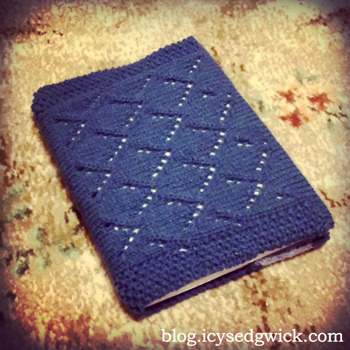
I've talked a bit about the new Twitter community I've found, #craftblogclub, which meets on Tuesday evening between 7 and 8pm UK time. Our fabulous founder, Emma Berry, set us all a creative challenge for September - I finished this last week but it's taken me until now to post! Our challenge was to create a notebook cover using whichever craft we liked. As much as a sewn cover might have been quicker, sewing has never been (and I suspect will never be) my forte, so I decided to knit one. I even went so far as to concoct a pattern myself.
This is the first time I've written a pattern, so I hope it makes sense. If you want to adapt it, bear in mind the central chevron pattern is worked in blocks of twelve stitches and sixteen rows, but you can always add more stocking stitch rows for the flaps, or more for the spine, if your notebook is bigger than mine. You'll also need to take yarn into account - I've used 100% acrylic DK as I had some lying around - I didn't have enough so part of the back flap is knitted in a different colour, but a 100g will easily be enough. My notebook measures 21cm by 16cm and is 1cm thick.
Using 4mm needles, cast on 48 stitches using your preferred method.
Row 1 - Knit.
Row 2 - Purl.
Repeat these rows another eighteen times so you have 20 rows of stocking stitch.
Now begin the pattern for the front cover. There is a moss stitch edging so on each right side row, add (k1, p1, k1, p1, k1) to either end of the chevron pattern. On each wrong side row, add (p1, k1, p1, k1, p1).
Row 21 - Moss stitch band, (yfwd, skpo, k10)x3, moss stitch band.
Row 22 - Moss stitch band, p36, moss stitch band.
Row 23 - Moss stitch band, (K1, yfwd, skpo, k7, k2tog, yfwd)x3, moss stitch band.
Row 24 - Row 22 - Moss stitch band, p36, moss stitch band.
Row 25 - Moss stitch band, (K2, yfwd, skpo, k5, k2tog, yfwd, k1)x3, moss stitch band.
Row 26 - Moss stitch band, p36, moss stitch band.
Row 27 - Moss stitch band, (K3, yfwd, skpo, k3, k2tog, yfwd, k2)x3, moss stitch band.
Row 28 - Moss stitch band, p36, moss stitch band.
Row 29 - Moss stitch band, (K6, yfwd, skpo, k4)x3, moss stitch band.
Row 30 - Moss stitch band, p36, moss stitch band.
Row 31 - Moss stitch band, (K3, k2tog, yfwd, k3, yfwd, skpo, k2)x3, moss stitch band.
Row 32 - Moss stitch band, p36, moss stitch band.
Row 33 - Moss stitch band, (K4, k2tog, yfwd, k1, yfwd, skpo, k3)x3, moss stitch band.
Row 34 - Moss stitch band, p36, moss stitch band.
Row 35 - Moss stitch band, (K2, k2tog, yfwd, k5, yfwd, skpo, k1)x3, moss stitch band.
Row 36 - Moss stitch band, p36, moss stitch band.
Repeat this block three times - the pattern block should be 48 rows. That finishes the pattern for the main cover. Knit ten rows of stocking stitch, continuing the moss stitch pattern at either edge.
Repeat the above pattern block of 48 rows, continuing the moss stitch edge, for the back cover. Knit twenty more rows of stocking stitch for the inside back flap, and cast off. With right sides facing, sew the edge of the flap to the cover at either side for the back, and repeat for the front. Turn the right side out and slip onto your notebook!

Published on September 29, 2013 07:18
September 27, 2013
#FridayFlash - Alone No More
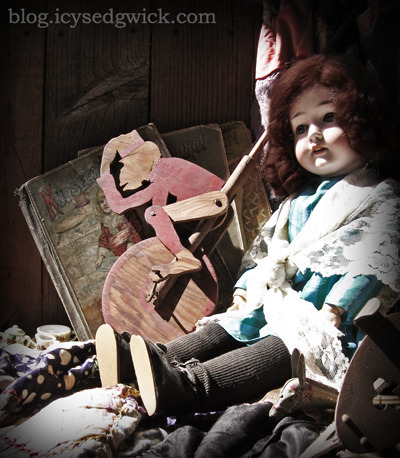
Image by Foobean01, edits by me
Lily arrived by accident one day, a dark haired doll among a box of blonde angels, and Mrs McGarry had never quite known what to do with her. For a time, Lily had shared a shelf with them, and late at night after the shop was closed, she'd tried talking to the other dolls. They never replied, just staring straight ahead with their glassy stares.
During the day, they all sat on their shelf opposite the door. Lily watched each day as another little girl came empty-handed to the toy shop, and left clutching her brand new doll. Occasionally one of the girls would pick Lily up, and she would smile her best smile, wondering what sort of owner this little girl would be, and then she would be put back on the shelf having simply been moved to make way for the blonde dolls behind her.
Mrs McGarry sold the last of the blonde dolls one rainy Thursday afternoon. Lily watched the doll disappear out of the door in the carrier bag of a father eager to please his daughter on her birthday. With the shelf to herself, Lily felt sure she'd be chosen now. She'd be a good doll, happy to play dress up and accompany her owner where she went.
A large cardboard box arrived on Friday morning, and Mrs McGarry unpacked a new shipment of dolls. Lily's heart sank at the sight of so many new blonde rivals. The dolls were arranged on the shelf, and Mrs McGarry lifted Lily higher, to the top shelf. Her new companions were unfashionable tin soldiers, a scruffy teddy bear and enough dust to stuff a pillow.
"The same thing happened to us, you know," said the bears, a brown gentleman with gingham patches on his paws.
"Don't worry, ma'am, we all take care of each other up here," said one of the soldiers.
"Why didn't any of the little girls choose me?" asked Lily.
"You can never tell what children are looking for. Mostly they just want the same as everyone else," replied the brown bear.
Days passed and Lily continued to watch the new arrivals leave the shop with their new owners. Once or twice, little girls looked up and saw her, perched on the edge of the shelf looking down, but none of them returned her smile. The days turned into weeks, and soon Mrs McGarry was decorating the shop for Christmas. An elderly woman spotted the brown bear and bought him for her friend who had apparently never had a teddy of her own. Even the tin soldiers were taken down from the shelf, bought by an antiques dealer for his Victoriana-obsessed son.
Two days before Christmas, Mrs McGarry arrived at the shop early. She saw the shelf opposite the door and screamed. Every single one of the blonde dolls, arranged so beautifully for her seasonal display, had been maimed. Tufts of hair lay all over the floor, and deep cuts mutilated the vacant expressions of the dolls. The ornate scissors that she usually kept behind the till for cutting wrapping paper lay on the floor.
An hour later, her daughter arrived. Glenda was not the hysterical type, and she packed away the butchered dolls while Mrs McGarry created a new display with toys filched from other parts of the shop. At the centre of it sat Lily, fetched from the top shelf and dusted down. Glenda straightened the doll's dark curls and wiped a smudge of dirt from her nose. She couldn't remember Lily's smile being so hopeful before.

Published on September 27, 2013 03:10
September 23, 2013
How to use Google +

Many of us have spent time focussing on blogs, Facebook and Twitter as a means of connecting with others and promoting our work, although recent years have seen an explosion in social media possibilities. We can now promote work through Pinterest, Instagram, Google +, and countless others besides. Despite its initial popularity, I think Google+ hasn't caught on quite the way it should have done because people aren't entirely sure how to use it. This post is intended as a quick introduction to its main features, and how you can use them to promote your work, and connect with others.
Circles
Circles are a brilliant addition to social media, allowing you to filter your news feed according to specific groups of friends, and you can post to certain circles to make sure that you have a modicum of control over who sees what. For example, you might have circles for fellow crafters/writers, colleagues, family and other friends. Your colleagues might not be interested in whatever you've been making or writing lately, in the same way your family might not be interested in work-related posts. When adding friends, simply add them to the right circle (people can be in more than one circle) and choose that circle when posting. If you're not bothered who sees what, you can just select 'Public' or 'Your Circles' - the former makes the content public, the latter means only those people you've added to any circles can see it.
Hangouts
Imagine a version of Skype that actually works, and lets you connect via video chat to several people at once, and that's what the hangouts function is all about. Hangouts aren't 'closed' so anyone involved can invite someone else, so you can end up chatting to people you didn't know beforehand.
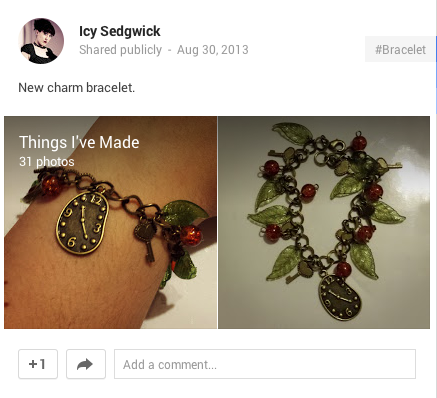
Posts
When you create a post, you get the opportunity to add a lovely focal image at the top of the post, which is a wonderful way to showcase photos of your work, or photos related to the content of your post. It's much more visual than Facebook, with its piddly thumbnails. I post photos of the things I've made into a specific album, and look how big and lovely the images are when they show up in my newsfeed. As for photos, if you've got an Android phone, you can opt to have photos instantly upload to Google +, and it's then up to you to choose which to actually post publicly. It's a nice feature if you're worried you might lose your phone - and therefore your photos. If you host your blog on Blogger, you can also integrate your account with Google + for cross-posting.
There is also an option to email the members of your circle to let them know you've posted something on Google +. Personally, I find this massively intrusive - I'll check Google + when it suits me, in the same way I keep track of blogs in Feedly so I don't need an email to tell me when a new post has gone up. Use this feature with caution because you don't want to be accused of spam, particularly if the post you're emailing about is a sales pitch.
There's a social media rule of 80/20 - 80% of posts should be about things besides yourself, and 20% are you and your product. Give people a reason to engage with you. I post a lot of links to web posts I find interesting, with a personal recommendation as to why I find them interesting. I only post links to my own writing once a week for my free flash stories on my blog, and even then, I'm not selling.

Profiles
The profiles on Google + are rather extensive - I've taken advantage of the 'skills' feature in the 'Work' box to add all the things I do in my spare time as I see them as skills, not just hobbies. I could fill in the employment box but I can't see the point at the moment as I'm using Google + for my writing and handmade crafts work, not my actual day job, but if I wanted to connect with my colleagues, then it would be easy enough to add my current and former jobs.
Make sure you upload a good profile photo as this will appear in Google search results if people search for things you've posted about. The benefit? People are more likely to click on a link if it looks like a real person wrote the post.

You also get the option to put a cover image on your profile, and it's a lot bigger than the one Facebook lets you have. Your maximum size is 2120 x 1192 pixels so you've got plenty of pixels to make your image look clear as a bell. Make sure your image scales properly, and bear in mind where your profile photo will appear so you don't cover up a vital part of your cover image. As well as a profile, you can also set up a page as well, particularly if you have a blog you want to promote.
You can also add links to your presence elsewhere, such as Pinterest, Twitter, Instagram etc., making it easier for your new Google + contacts to find you elsewhere too.

Communities
Communities are a lot like Facebook groups or Twitter #hashtag communities, but again, posts have images attached, so it looks a bit nicer than the page full of text that can comprise a Facebook group page. You can find other people with your interests and interact with them. I'm only a member of six communities currently, and I don't interact nearly as much as I should, but it's a good set up and a good idea so I'm going to focus on engaging with other people as much as I can.
+1
Add a +1 button to your posts so people can show they approve - it's a little like the 'like' button on Facebook. If you have a powerful presence with a lot of people that you engage with, it'll boost your search rankings on Google. Also, if you link your website to your Google+ profile, your photo will appear whenever people search for topics you've discussed on your blog.
It does sound like a lot of work, and building a profile and a friend base can seem like a lot of hard work, but regular engagement on Google + will help your Google ranking for websites and pages. You can categorize your friends, and you won't have to pay to promote your posts. Google + has more of a visual bias than Facebook, meaning all of your lovely images of your crafty work won't go unnoticed!
Come and find me on Google + here, or on Pinterest, Instagram and Twitter!

Published on September 23, 2013 11:06
September 20, 2013
#FridayFlash - Caged

Image by johnnyberg. Edits by me.
Roll up, roll up, we got the best o' the worst in 'ere! Roll up!
Yes, you sir, and you madam, come this way 'n see the weirdest 'n wonderfullest o' God's creations. We got the Bearded Lady, the most beautiful woman in Christendom, with a beard fit for the Lord 'imself! Step right up, see 'er for yourself. Step closer, she don't bite. That's right, a little bit closer, ain't she beautiful?
Now, you madam, how's about you come this way? We got the Dog-Faced Boy down 'ere. Ain't he cute? Don't pet 'im or he will bite! Don't see if he don't! We found 'im in darkest Peru, and gave 'im an 'ome. I'm all heart, really, though I don't like to brag. Why don't you stop and give 'im a treat?
Ah, the esteemed gentleman in the top 'at. You want to see the Siamese Sisters, don't you? Joined at the 'ip, they are. Right pair of troublemakers. But aren't they sweet? That's Cecila and Emmeline, left to right. Aw, I knew you'd like 'em. That's right, go ahead, go on in. They'll give you a right royal welcome, oh yes they will.
And you, my dear. Bet you're wonderin' what we got down 'ere at the end, ain't yer? We got somethin' very special indeed lined up for you. Go on, 'ead on down there, I'm right behind yer. Does that birthmark o' yours hurt at all? I ain't seen one like that in years. Covers 'alf yer face, it does. Pity, you're such a pretty young thing. Oh, yer used to people starin'? Well that's 'andy to know. Yeah, this 'ere is our last cage. Yeah, it's empty.
It's for you.

Published on September 20, 2013 03:04
September 17, 2013
#GuestPost - Grammar for Superheroes
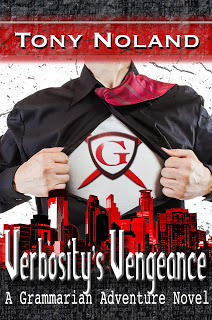
Superheroes are big business at the moment, though they've never quite made the leap from comics to novels. Hopefully Tony Noland's new offering, Verbosity's Vengeance: A Grammarian Adventure Novel, will make all the difference. I was lucky enough to beta read it for Tony and I can honestly say it's an awesome read. So it's my pleasure today to let Tony have a chat about the book!
Q. Welcome, Tony! Introduce your book for everyone.
The book is "Verbosity's Vengeance: A Grammarian Adventure Novel". It's about the Grammarian, a superhero who uses grammar- and punctuation based powers. For example, he can catch a thrown hand grenade by projecting a full stop, slice through steel bars with a cutting remark, or contain an explosion with nested parentheses. He's smart, fast and strong, but his pursuit of the nefarious Professor Verbosity is running into trouble. Verbosity is up to something big, and the Grammarian is going to thwart him... assuming he can hire a decent sidekick. He not only has to deal with interference from the Avant Guardian, a second-rate hero who wants to be taken seriously, he also has to deal with his own attraction to a beautiful college professor with a thing for superhero technology.
Q. Who is your intended audience and why should they read your book?
There's an intersection of people who like superheroes with people who like clever wordplay and word nerd humor. This book is squarely targeted at them. If they like their superheroes to be realistic, with real world concerns about friends, jobs, and romance, so much the better. It's a fast-paced adventure story that puts a lot of human in the superhuman.
Q. Tell us a little bit about your cover art. Who designed it? Why did you go with that particular image/artwork?
I worked with Sabrina Zbasnik for this cover. There were several concepts that we reviewed before settling on this one. I knew from the first that the cover had to tell the reader two things: 1) superhero, 2) grammar. I love this artwork. The chest reveal is wonderfully iconic, so much so that the big G becomes a wink and a nod to the entire superhero genre. The overlay of the hero above the city skyline packs a lot of visual information, especially as the cityscape is covered in words. The alliterative title is another nod to the adventure genre, being clear as to what kind of book this is, even as it fleshes out the image, introducing both the villain (Professor Verbosity) and the hero (the Grammarian).
Q. Who is your favourite character? Why?
My favorite character is Alex Graham, the man behind the Grammarian. He's found his niche among all the heroes of Lexicon City and has the respect of his colleagues and the city's criminal element. Even as he's overworked by Professor Verbosity's latest plot, he still wants to leave room in his life for romance. I don't want to give away too much of the plot, but some of my favorite scenes to write were the interactions between Alex and Kate Hunter, the object of his affections. They both have secrets, so the process of building up mutual trust is delicate. I think I liked writing those parts of the book even more than the explosive fight scenes between the Grammarian and his enemies.
Q. Give us an interesting fun fact about Verbosity's Vengeance.
It was based on a #FridayFlash story of 1000 words, which I used as the seed idea for a 52,000 word NaNoWriMo novel. This final book is 107,000 words, about average for science fiction. I'd hold this book up as an example to anyone with any lingering doubts about NaNoWriMo as a valid writing process.
Q. How about the writer behind the book? Tell us something about yourself.
I live in the suburbs of Philadelphia, PA. I'm middle-aged, married with four kids and a dog. No superpowers, unfortunately, unless you count double-jointed thumbs and the ability to wiggle my ears independently of each other. I like blue cheese, anchovy pizza, and hoppy beers.
Q. What can we expect from you in the future?
I'm working on a new novel, but I'd prefer not to say what it's about. It's also science fiction.
Q. And now, before you go, how about a snippet from your book?
A gruesome sentence flew toward the Grammarian, blasted from the barrel of Professor Verbosity’s latest weapon, the Concept Cannon. Festooned with a dozen hook-like prepositional phrases, the complex construct spun widely to ensnare the superhero. Anticipating the attack, twin thunderclaps exploded from the Grammarian’s gauntlets as he fired a powerful pulse of parentheses from one hand and a simultaneous shower of semicolons from the other.
The punctuations found their marks, creating nodal points that shattered the sentence into a cloud of fragments. With an electric shriek of memetic energy, the construct collapsed like an accordion. Discrete, unconnected phrases bent and flexed harmlessly around the Grammarian.
“Give up, Professor Verbosity,” he said. “You should know by now that sheer weight of words is no match for the power of punctuation!”
He shifted into a fighting stance and faced his opponent, who had backed to the far side of the room. Professor Verbosity lifted the Concept Cannon and pulled a lever. The barrel swiveled into an angular projection. Blue sparks shone along the length of the weapon as electronic circuits reconfigured themselves.
“Is that so, hero? Let’s see how well you can withstand my Redundancy Ray!”
“You need a new bag of tricks, Verbosity. I’ve already seen that a dozen times. Now, give up!”
The supervillain smiled in response.
“You always try to bluff your way out of difficulty, don’t you, Grammarian? I can’t say I don’t admire the attempt to win with words instead of brute force, but in this case, I’ll use both.” The weapon in his hand was now shaking with barely contained power, long plasma streamers flowing from end to end. “True, my Redundancy Ray is an old favorite, but I haven’t shown it to you since I added the Rephraser Refractor!”
Blue lightning exploded from the weapon. In less than a second, a million microfilaments of memetic concept energy wrapped themselves around the Grammarian. Knocked to the ground by the force of the impact, he had no chance to react before the energy coalesced into a single, coherent sentence. Within the densely convoluted word-construct, the Grammarian was immobilized.
It’s about time he pulled out a real weapon, the hero thought. If I’d had to duck and dodge much longer, he surely would have begun to realize that I was holding back.
Professor Verbosity laughed in triumph, delighted to see his foe struggling in the grip of the memetic energy his weapon was projecting. The Grammarian struggled even more vigorously and threw in a growl of frustration to enhance the effect. For a moment, he thought he might have overplayed the acting, but the hero could see that Verbosity was convinced of his triumph.
Supervillains are suckers for cliché, the Grammarian thought, every one of them.
“You’ll never win, Professor Verbosity!” He spit his archenemy’s name with obvious contempt. Pinned to the floor under the weight and complexity of shimmering word-memes, he fought for breath as his bonds grew ever tighter. Now, his gasping was only partly exaggerated for effect. Although allowing himself to be captured was part of the Grammarian’s plan to trick Verbosity into revealing his latest plot, Lexicon City’s smartest hero feared that that he’d underestimated his foe.
Professor Verbosity laughed. “Ah, my dear Grammarian,” he replied, “I have already won, insofar as the first and most crucial step in winning is to render you utterly and completely helpless. These sentences are not only long and complex enough to entangle you completely while you try to parse out subject and object amid the subtending and supporting prepositional and participial phrases, they are also perfectly correct grammatically, which renders you powerless to break free!”
Under the triumphant gaze of his nemesis, the Grammarian was indeed struggling, completely snared in the thick ropes of words. He tried to find some flaw, some grammatical mistake that he could exploit. With all his super-powered lexicographical might, he scanned and rescanned the sentence, though it was blindingly painful to do so. Being captured was part of the plan; being rendered unconscious was not. He wanted some avenue of recourse if he needed to go to one of his backup plans.
Unfortunately, Verbosity had gone to great lengths this time, figuratively and verbally. If only there were an inconsistent verb tense, a dangling or misplaced modifier, even an intransitive verb used transitively, but there were no grammatical mistakes to latch onto. The Grammarian needed to get to the bottom of his foe’s plot and time was running out more quickly than anticipated.
... TO BE CONTINUED...

/////
"Verbosity's Vengeance: A Grammarian Adventure Novel" is on sale at Amazon for $2.99.
Tony Noland is a writer and editor in the suburbs of Philadelphia. His blog is at http://www.tonynoland.com, and you can find him on Twitter as @TonyNoland, and on Facebook at https://www.facebook.com/TonyNolandAuthorPage.

Published on September 17, 2013 01:30
September 16, 2013
666th post - Handmade Necklaces
Yes, it amuses me that according to Blogger, this is my 666th post! Who would have thought it? Anyway, inspired as ever by my continuing attempts at making jewellery, and the fabulous #craftblogclub group on Twitter, I got out my big box of bits and decided to make a couple of necklaces this afternoon. The first is for me, hence the shorter chain as I like pendants to be more like chokers.
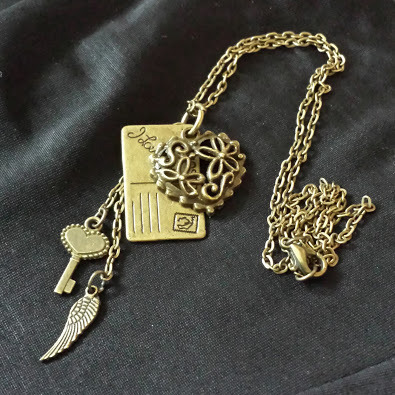
It's comprised of a heart charm and an envelope charm, with the addition of a wing and a key charm on shorter lengths of chain. I've never really made 'dangle' pendants, or necklaces which involve more than one pendant, but I'm quite pleased with how this one turned out. I liked it so much that I decided to make another one with a twist.
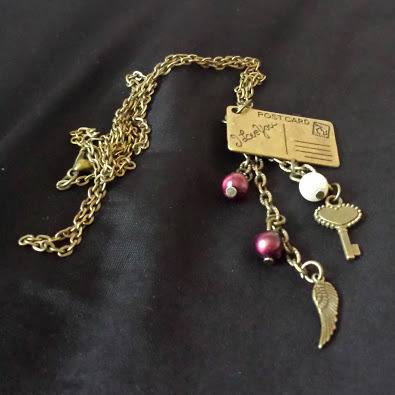
This one features the same envelope charm, with the addition of the same key and wing charms, but I also added beads to the design, particularly two burgundy beads that are more of a deep purple, and a single pearl coloured bead to add some contrast. I picked these colours as the whole necklace has an antique bronze finish, and I thought the colour scheme worked well. The chain is slightly longer, at approximately 18", but the difference with this one is it's actually for sale. It's £8, plus postage to wherever you happen to be. Email me at icy (at) icysedgwick (dot) com if you're interested!
But now for the big question. Which do you prefer - silver or gold?

It's comprised of a heart charm and an envelope charm, with the addition of a wing and a key charm on shorter lengths of chain. I've never really made 'dangle' pendants, or necklaces which involve more than one pendant, but I'm quite pleased with how this one turned out. I liked it so much that I decided to make another one with a twist.

This one features the same envelope charm, with the addition of the same key and wing charms, but I also added beads to the design, particularly two burgundy beads that are more of a deep purple, and a single pearl coloured bead to add some contrast. I picked these colours as the whole necklace has an antique bronze finish, and I thought the colour scheme worked well. The chain is slightly longer, at approximately 18", but the difference with this one is it's actually for sale. It's £8, plus postage to wherever you happen to be. Email me at icy (at) icysedgwick (dot) com if you're interested!
But now for the big question. Which do you prefer - silver or gold?

Published on September 16, 2013 08:12
September 12, 2013
#FridayFlash - The Wilson Street Mission
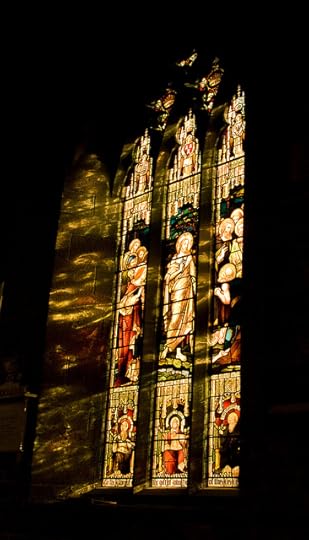
Two weeks after my roommate's boyfriend moved in, I started taking my evening meals in the diner two doors down from our building on Wilson Street. It was the only way I could get any peace; Cody didn't know what the word 'quiet' meant, and the TV was permanently tuned to the sports channels. He ate like a pig at a trough, and Lesley was too grateful to have a boyfriend to say anything.
The diner was the kind of place where the staff know the regulars, and no one talks unless they have something to say. I started sitting at one of the tables by the window, my netbook open in front of me, where I could write and watch the street as I ate. I often stayed an hour or so after I'd finished eating, and Phyllis would ply me with black coffee and nibbles.
The Wilson Street Mission was across the road from the diner. People would drop by alone or in pairs every night, but on a Wednesday, a whole congregation would turn up. I'd watch maybe fifty people pile into that old red brick building, and at 7:30pm sharp, the doors would close, and I'd watch the light show against the stained glass windows at the front of the Mission. By the time I left an hour later, they were all still in there.
I watched this go on for a month - one night, I even tried to see if they were still there at midnight, but our apartment was on the wrong side of the building, and I didn't want to venture into our street so late at night.
One Wednesday night, as Phyllis was taking away my soup bowl and pouring me another coffee, I asked her about it. She shook her head at me.
"No, I don't know nothin' about that Mission there, 'cept it does a lotta good work for folk in this neighbourhood."
"Why's it so busy on a Wednesday?"
"I guess the pastor got somethin' special to say."
I knew Phyllis wasn't telling me everything but there was nothing I could do - if she didn't want to tell me, then I couldn't make her. I decided to stay a little later that night - the diner closed at 10pm, so I settled down with my coffee, and a slice of cheesecake, and started writing.
The diner was empty by 9, and Phyllis went home, leaving just Cathy working the front. Marco pottered around out back, bursting into snippets of opera he'd picked up back home. Cathy never spoke to anyone, so I didn't bother asking her about the Mission, and she didn't ask why I was working late. She just brought me another coffee, and went back to cleaning the counter.
My intention had been to see when the congregation left the Mission, but I got engrossed in my work and forgot to look. I'd made good progress on my novel when Cathy coughed, and looked at the clock. 9:55pm. I nodded, shut down my netbook, and paid my check. As I left the diner, I noticed the Mission's doors were still closed, and the light behind the stained glass windows was throwing coloured shapes across the road. A chorus of singing voices filled the late night air, and echoed along the empty street. It sounded beautiful and haunting at the same time, and I couldn't stop myself from crossing the road.
The information board outside the Mission featured special events or forthcoming visits by doctors and priests, but it was blank for Wednesday night. I tried to look through one of the windows but they were too high up in the wall. The singing definitely came from inside, but the congregation sounded like a lot more than just fifty people.
On a whim, I tried the door. The handle stuck at first, but I put all my weight on it, and the door opened. I pushed it inwards with my fingertips, hanging back in case anyone came to see what I wanted. I expected someone to rush over and send me packing, but no one came. Feeling bolder, I poked my head around the edge of the door.
I expected to see a congregation, enraptured and following an enthusiastic pastor, with bright lights shining behind him, lights that I could see outside through the stained glass. Instead, the building was empty and in darkness. I figured it would be like the old soup kitchen four blocks over, but it was laid out like a theatre. A layer of dust covered the velvet flip seats that faced a platform at the end of the room - no one had been inside for years.
I couldn't hear the singing any more, or see the light, so I turned to leave. The door swung shut in my face, and the darkness swallowed me up. I felt around on the door for the handle, but there was nothing on the inside, just smooth black wood. Suddenly, a voice broke the silence.
"Good evening, Celine. We've been expecting you."
A hand touched my shoulder and I screamed.
I've been screaming ever since.

Published on September 12, 2013 21:00
September 9, 2013
Ode to Autumn
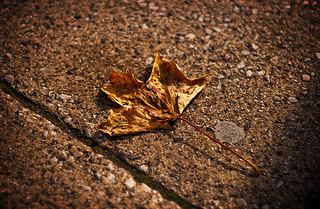 Our temperature here in Newcastle was a whopping 24°C last Wednesday, dropping to 15°C on Saturday and Sunday. With the temperatures dropping, and heavy rain beginning to set in, the weather forecasters are all adamant that summer has slipped into autumn (though only one has announced that "winter is coming"). While the Autumn Equinox is still some days away yet, there is certainly a new nip in the air, and a sense of melancholy as the nights draw in, while the idea of early morning sunshine begins to feel ludicrous. Was the summer really so long ago?
Our temperature here in Newcastle was a whopping 24°C last Wednesday, dropping to 15°C on Saturday and Sunday. With the temperatures dropping, and heavy rain beginning to set in, the weather forecasters are all adamant that summer has slipped into autumn (though only one has announced that "winter is coming"). While the Autumn Equinox is still some days away yet, there is certainly a new nip in the air, and a sense of melancholy as the nights draw in, while the idea of early morning sunshine begins to feel ludicrous. Was the summer really so long ago?But is autumn as a season really something to be dreaded? John Keats certainly didn't think so - back in 1819, he considered it to be the season of "mists and mellow fruitfulness", and waxed lyrical about the ripe fruit, and the specific songs of autumn that differ so vastly from the songs of spring. I must admit, I'm no fan of going to work and coming home from work in the dark, and I'm even less enthused about the daily drenching as rain plagues my commute, but I'm trying to think positively about the changing seasons. So here are my top three things about autumn.
1) The Clothes
No more worrying about needing to have a "bikini ready" body, or needing all visible limbs to be in tip top condition - I'll be spending the next few months in comfortable jumpers, squishy handmade cowls and warm boots (though, in all fairness, I practically live in my Doc Martens even when the temperature goes into the mid-thirties). I can bust out my collection of hand knitted accessories, and choose from an array of hats, handwarmers, scarves, cowls and shawls to keep myself cosy when the nights draw in.
2) The Comfort
There's something comforting about making it home just in time to see the heavens open, and being able to sit by a fire while watching the downpour outside. Grey skies, chilly winds and falling leaves seem oddly romantic in their melancholy way when you're enjoying them inside, hopefully while enjoying the smell of freshly baked cinnamon biscuits. Plus you've got more of an excuse to ply yourself with hot drinks and comforting snacks.
 3) The Colours
3) The ColoursI love spring when the world comes back to life, but I equally love autumn as the trees prepare for the coming winter - this year I'll be heading up to Howick Hall Gardens to see their collection of New England trees burst into dazzling autumnal hues. The blaze of red and gold somehow takes the edge off a dreary morning, and the beauty of the season seems to be nature's way of compensating us for the cold darkness that lies ahead. Also, if you're anything like me and you find beauty in sad, doleful things, there are few things more glorious than a tree repainted in autumn's finest colours looming out of an early morning mist.
What about you? Do you love autumn, or do you yearn for spring already?

Published on September 09, 2013 23:00
Using Silver Clay
I've always enjoyed messing about with anything that lets me use my hands, and I was a big fan of Fimo Soft for a long time. I've been making jewellery for a little while now, and I always enjoy finding new materials or techniques to try. I was browsing available one-day workshops around Newcastle when I came across a Silver Clay class at the Mushroom Works. I've known about metal clay for a while but haven't been able to get my head around how it works, so I thought I'd go along and give it a go.
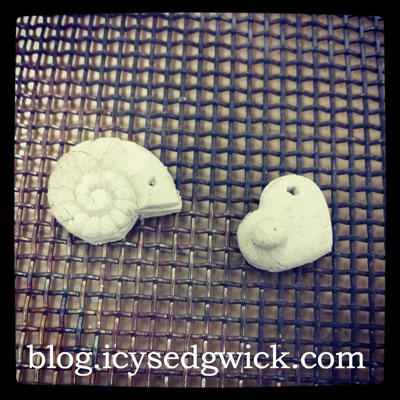
Silver clay, in this case Art Clay Silver Standard, looks just like regular polymer clay when it first comes out of the packet. You can roll it out, cut out shapes, all the usual jazz you'd expect from clay. I made these shapes by pressing the clay into silicon moulds, the type of thing you might use with sugar paste for cake decorating. The ammonite on the left came out looking like that, but I added the last of my clay as a tiny ball onto the heart on the right.
Next stage is to dry the clay - we used heat guns but you could leave it out overnight. Once it's dry, you can use emery paper to smooth off the edges and buff out any imperfections or fingerprints, and you can use a pin drill to make the holes. Then it needs to be fired.
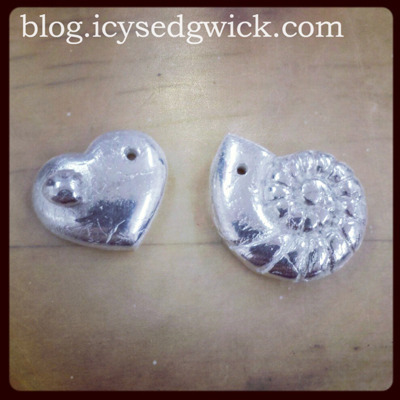
We used a kiln, in this case at 650°C, and it comes out white (you can also use a blowtorch or a gas stove). The pieces also shrink by up to 10% because the binding agent holding the silver particles together burns off in the firing process, leaving behind 99.99% silver. Using a brass brush, you brush off the white coating, revealing the silver underneath. An agate burnisher helps to buff it up to a mirror shine.
Next, I used the pin drill again to make sure the hole was big enough, and I attached a jump ring so I could hang it from a cord. A length of 3mm black satin ribbon helped turn the heart into this choker...
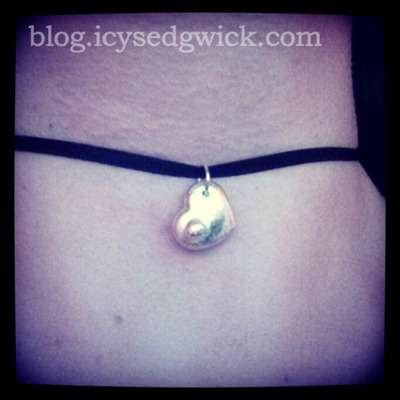
And I repeated the process for the ammonite (which I only realised looked like Ursula's shell from The Little Mermaid after I was finished).
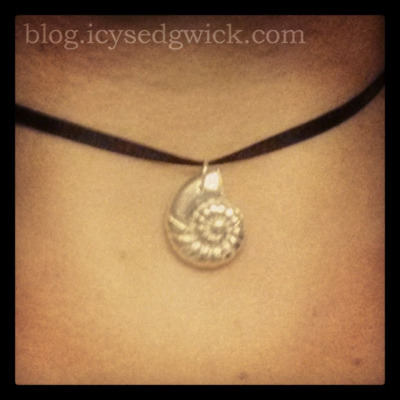
It still baffles me how I could now have two pendants made of silver which started life looking like clay, but it's definitely something that I want to experiment with further. I think I'll try the copper next as it's cheaper, and while it can't be fired on the stove, it can be fired with a blowtorch, making it a more accessible route into metal clay jewellery!
Have you ever used metal clay?

Silver clay, in this case Art Clay Silver Standard, looks just like regular polymer clay when it first comes out of the packet. You can roll it out, cut out shapes, all the usual jazz you'd expect from clay. I made these shapes by pressing the clay into silicon moulds, the type of thing you might use with sugar paste for cake decorating. The ammonite on the left came out looking like that, but I added the last of my clay as a tiny ball onto the heart on the right.
Next stage is to dry the clay - we used heat guns but you could leave it out overnight. Once it's dry, you can use emery paper to smooth off the edges and buff out any imperfections or fingerprints, and you can use a pin drill to make the holes. Then it needs to be fired.

We used a kiln, in this case at 650°C, and it comes out white (you can also use a blowtorch or a gas stove). The pieces also shrink by up to 10% because the binding agent holding the silver particles together burns off in the firing process, leaving behind 99.99% silver. Using a brass brush, you brush off the white coating, revealing the silver underneath. An agate burnisher helps to buff it up to a mirror shine.
Next, I used the pin drill again to make sure the hole was big enough, and I attached a jump ring so I could hang it from a cord. A length of 3mm black satin ribbon helped turn the heart into this choker...

And I repeated the process for the ammonite (which I only realised looked like Ursula's shell from The Little Mermaid after I was finished).

It still baffles me how I could now have two pendants made of silver which started life looking like clay, but it's definitely something that I want to experiment with further. I think I'll try the copper next as it's cheaper, and while it can't be fired on the stove, it can be fired with a blowtorch, making it a more accessible route into metal clay jewellery!
Have you ever used metal clay?

Published on September 09, 2013 00:00



